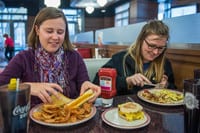It’s the start of 2018, which means the “new year, new me” resolutions are picking up some good momentum by now. Hitting the gym more often is definitely one of my resolutions, and if our resolutions are on the same page, then this post can be of some help to you!
Work out supplements… we see them advertised all over our social media pages, and if you are walking into your local GNC, or Vitamin Shoppe the selection can be intimidating. What I’ve learned so far is that there are supplements that you take as a pre-workout, and supplements that do just as they are named, supplement.
Pre-workout Supplements:
What’s the scoop? Boosting your performance is all part of the plan. Growing bigger muscles, having quicker gains, and hoping for an easy solution is something we all strive for. Most of us understand that easy isn’t necessarily so, and may not entirely be the correct way in doing something. Unlike medications, workout supplements are not as strictly regulated by The Food and Drug Administration (FDA), which means dangerous ingredients may be incorporated without the knowledge of consumers. Some of the ingredients may actually have detrimental effects, and potentially cause death.
1, 3- dimethylamine, methylhexanamine or geranium extract—also known as DMAA is an ingredient that has been found illegally in some dietary supplements, where manufacturers mask the component as a “natural” stimulant. In 2013, a case report was published in the Clinical Journal of Sport Medicine, highlighting an incident where a 21- year old male suffered from cardiac arrest after ingesting a workout supplement containing DMAA. Structurally, DMAA is similarly related to amphetamine, methamphetamine, and MDMA. DMAA does not produce any type of stimulant similar to the mentioned substances, but if you are set to take a urine drug test for a new job, or professional program at The Ohio State University… heads up, you may fail.
Good news, DMAA has been banned by the FDA after the unfortunate incident that occurred in 2013, however, there are still some supplements through online purchase that may have the ingredient incorporated within the product, and I would recommend reading the back of the nutrition label before purchasing any type of supplement. The discontinued substance that contained DMAA was specifically the pre-workout supplement marketed as Jack3d made by USPLabs.
Regular Supplements:
“First off, let me drink some protein.” Protein supplements are frequently consumed by athletes, as well as those who work out recreationally. There is much debate on the theory of amount of protein per day a person should intake and the timing of supplementation, and if you have any questions towards these matters PubMed.gov is a good source for you to do some more research about the topic.
Protein powders come in three common forms, those being—whey, soy and casein. A study by Kanda, A. et al in 2016, looked at the co-ingestion of all three substances and their effects on muscle protein synthesis after exercise in rats. The results of the study demonstrated a difference in peak time according to the type of protein ingestion, the authors concluded that whey protein was quicker to initiate the process compared to casein and soy.
Branched chained amino acids (BCAAs) especially leucine have been shown to increase muscle synthesis after exercise. Leucine is another component to keep an eye out for. Kanda, A et al. also noted that leucine displays a specific saturation point. The threshold described was around 43 mg of leucine, which means anything above this dose resulted in no further increase in the muscles anabolic response.
This is just the tip of the iceberg when it comes to the types of supplements that are available commercially, the big take away from this blog is to get you use to looking at the nutrition label located on the back of the products up for purchase. Speaking to your healthcare providers about any of your concerns is a good thing to do, especially if some of the components of your supplements seem a bit off.
Justin Corpus
PharmD Candidate 2018
References:
- Kanda, A. et al. Effects of whey, caseinate, or milk protein ingestion on muscle protein synthesis after exercise. Nutrients. 2016 Jun; 8(6): 339.
- Lioudmila, K et al. Cardiac arrest in a 21-year old man after ingestion of 1,3 dmaa—containing workout supplement. Clin J Sport Med. 2015 Jan; 25 (1): 23-25






